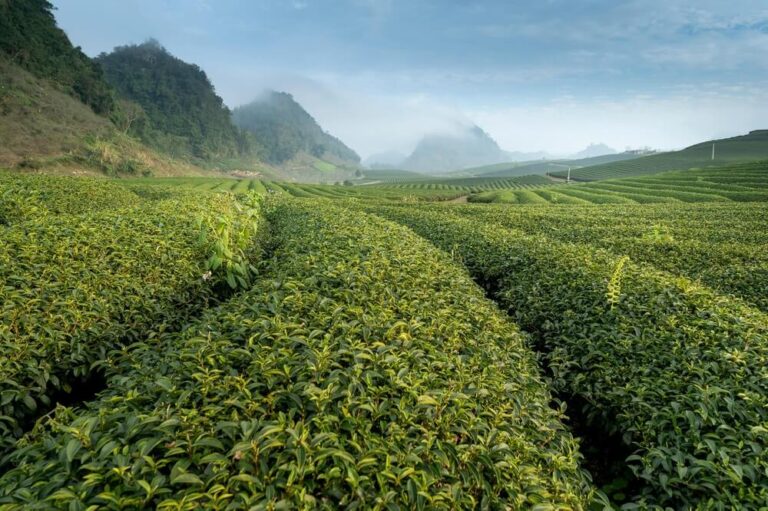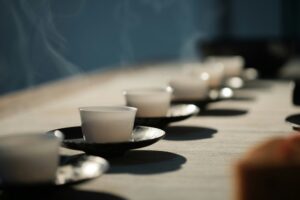The world of premium tea offers something extraordinary: finest loose leaf tea, representing the pinnacle of tea craftsmanship. Unlike conventional tea bags, these are whole, unprocessed leaves that preserve nature’s intended flavors and benefits. Each leaf tells a story of careful cultivation, expert harvesting, and masterful processing.
Premium loose leaf tea brands like Azenbor have elevated this ancient art form, particularly in crafting exceptional Oolong teas. These loose leaves, when properly brewed, unfold to release complex flavors and aromas that mass-produced teas simply cannot match. Whether you’re a seasoned tea connoisseur or new to premium teas, understanding what makes finest loose leaf tea special will transform your tea-drinking experience.
If you’re new to loose leaf tea, starting with a high-quality Oolong like Azenbor’s Honey Orchid Fragrance [Mi Lan] Oolong, Ginger Flower Fragrance [Jiang Hua] Oolong is a great way to experience the difference.
What Makes Finest Loose Leaf Tea Special?
The creation of exceptional loose leaf tea is an art form perfected over centuries, where nature’s finest ingredients meet human expertise. Each step in the journey from garden to cup plays a vital role in creating truly remarkable tea.
The story begins in nature’s most privileged tea gardens, often nestled in high mountain regions where perfect growing conditions exist. Morning mists roll through the mountains, providing natural humidity while mineral-rich soil nourishes the roots. In these ideal conditions, tea plants develop leaves with exceptional flavor complexity that mass-produced teas simply cannot match.
The expertise of tea masters becomes crucial during harvesting. Premium loose leaf teas require careful hand-picking at precisely the right moment, particularly during the first flush – the earliest spring harvest when young leaves contain their highest concentration of essential oils. Tea masters move through the gardens with practiced precision, selecting only the most perfect leaves and buds.
The transformation from fresh leaf to finished tea showcases generations of craftsmanship. Take Oolong tea, for example – the leaves undergo a carefully orchestrated oxidation process, where tea masters must recognize exactly the right moment to achieve desired flavor profiles. Each step, from withering to final firing, requires decisions that only come from years of experience. Azenbor’s Orchid Fragrance [Zhi Lan] Oolong , for example, undergoes a unique withering process that enhances its delicate floral aroma. Seasoned tea drinkers will appreciate the high-mountain terroir and delicate orchid fragrance of Azenbor’s Orchid Fragrance [Zhi Lan] Oolong.
This meticulous attention to detail throughout the entire process explains why premium loose leaf teas, such as those crafted by artisanal producers like Azenbor, offer such a remarkably different experience from ordinary tea. Azenbor stands apart due to its direct sourcing from small, family-owned farms in the Phoenix Mountains, ensuring unparalleled quality and a direct connection to the tea’s origin. When you understand the journey these leaves take, you begin to appreciate why finest loose leaf tea commands its position at the pinnacle of tea craftsmanship.
How to Identify Finest Loose Leaf Tea
The art of identifying premium loose leaf tea engages all your senses in a fascinating journey of discovery. Like a fine wine, quality tea reveals its character through multiple aspects, each telling part of its story. Understanding these qualities helps you appreciate and select truly exceptional teas.
The first impression comes from visual appearance. Premium loose leaf teas captivate with their natural beauty – whole, intact leaves that show careful handling from garden to cup. When you examine quality Oolong tea, for instance, you’ll notice the leaves are masterfully rolled or twisted, displaying consistent size and a subtle sheen that speaks to their freshness. This uniformity and craftsmanship reflect the tea master’s skill and attention to detail. Look for this in Azenbor’s Cinnamon Fragrance [Rou Gui] Oolong, where the leaves are expertly twisted to release their warm cinnamon notes.
The aroma experience begins the moment you open the container. Quality loose leaf tea releases a complex bouquet that hints at its character and processing. Fresh, clean scents should greet your nose, free from any musty or artificial notes. Premium Oolong teas might offer delicate floral notes or deeper roasted aromas, depending on their oxidation level. This natural fragrance profile becomes even more pronounced when the leaves meet hot water.
Watch the leaves dance as they steep – it’s a mesmerizing transformation that reveals much about the tea’s quality. Premium leaves gracefully unfurl, gradually releasing their stored flavors and aromas. Each leaf should expand fully while maintaining its integrity, demonstrating the careful handling it received during processing. This elegant unfurling continues through multiple steepings, with quality teas offering new dimensions of aroma and flavor with each infusion.
The resulting tea liquor should appear clear and bright, with a color characteristic of its variety. Notice how light plays across the surface, creating a natural sheen that indicates the presence of essential oils and beneficial compounds. These visual cues set the stage for the ultimate test – the taste.
When you finally sip the tea, premium quality reveals itself through a symphony of flavors that evolve across your palate. The initial taste should be clean and distinct, followed by subtle notes that unfold gradually. A hallmark of exceptional tea, particularly in varieties like Oolong, is its ability to offer a pleasant aftertaste known as “hui gan” in Chinese tea culture. This sweet, lingering sensation invites you to explore deeper into the tea’s character with each sip.
Experience this “hui gan” in Azenbor’s Ten Different Fragrance Oolong, where the subtle almond notes linger on the palate.
The finest loose leaf teas continue to reward your attention through multiple steepings, with each infusion revealing new aspects of their complex nature. This journey of discovery, from the visual beauty of the dry leaves to the lasting impression of the final sip, exemplifies why premium loose leaf tea commands such appreciation among connoisseurs worldwide.
Different Types of Premium Loose Leaf Tea
The world of finest loose leaf tea offers a rich tapestry of varieties, each with its own character and charm. Like fine wines, different tea types reflect their origin, processing methods, and the expertise of their makers.
Among these varieties, Oolong tea holds a special place in the hierarchy of fine teas. Semi-oxidized between green and black teas, Oolong showcases the tea maker’s highest art. Premium Oolong teas, like those crafted by Azenbor, can range from light and floral to deep and roasted, depending on their oxidation level. The leaves are carefully rolled or twisted, unfurling gracefully when steeped to release complex flavors that can evolve through multiple infusions.
Green tea, prized for its fresh, vegetal notes and health benefits, requires particular skill to process. The finest varieties, like Japanese Gyokuro or Chinese Dragon Well, preserve the leaves’ natural essence through careful heating that prevents oxidation. These teas offer a bright, clean taste that captures spring’s vitality.
Black tea, fully oxidized and rich in flavor, includes renowned varieties like Darjeeling’s muscatel notes and Yunnan’s golden tips. White tea, the most minimal in processing, preserves the natural sweetness of young buds and leaves. Pu-erh tea, aged like fine wine, develops increasing complexity over time.
Each type represents a unique expression of tea craftsmanship, offering tea enthusiasts a world of flavors to explore. Understanding these varieties helps appreciate the remarkable diversity within premium loose leaf teas.
The True Value of Finest Loose Leaf Tea
The value of premium loose leaf tea extends far beyond the simple pleasure of a beverage. Each cup offers a sensory journey that engages all your senses, creating moments of discovery and appreciation that mass-produced teas simply cannot match.
From a health perspective, these carefully processed leaves retain their full complement of natural compounds. Unlike tea bags that often contain broken leaves and dust, premium loose leaf teas preserve their antioxidants, minerals, and beneficial elements intact. The gentle unfurling of whole leaves during steeping releases these nutrients gradually, providing both immediate enjoyment and lasting benefits. (You can check our dedicated explaination for health benefits of oolong tea.)
Environmental consciousness adds another dimension to loose leaf tea’s value. Without excess packaging and processing, premium loose tea represents a more sustainable choice. Artisanal producers like Azenbor emphasize this responsibility through careful sourcing and minimal packaging, allowing tea lovers to enjoy their daily ritual while honoring environmental stewardship.
Azenbor’s commitment to sustainability extends to supporting traditional, low-impact farming methods that preserve the biodiversity of the Fenghuang Mountains. This includes promoting the use of natural fertilizers, discouraging the use of pesticides, and supporting the preservation of old-growth tea trees, ensuring the long-term health of the ecosystem
Perhaps most importantly, finest loose leaf tea connects us to an ancient tradition of craftsmanship, offering a moment of mindful appreciation in our busy lives. This combination of sensory pleasure, health benefits, and cultural connection makes premium loose leaf tea truly precious.
A Guide to Selecting Premium Loose Leaf Tea
Choosing the finest loose leaf tea can feel overwhelming with so many options available. However, understanding a few key principles can help you make informed decisions that enhance your tea experience.
First, consider the tea’s origin and processing. Premium producers like Azenbor provide detailed information about their tea gardens and crafting methods. Look for transparency in sourcing and clear descriptions of processing techniques. Quality teas often come with harvest dates and specific origin details, allowing you to understand exactly what you’re purchasing.
While premium loose leaf tea may command higher prices than commercial alternatives, consider its value per cup. Quality leaves can be steeped multiple times, often yielding three to five flavorful infusions. This makes the actual cost per serving quite reasonable, especially given the superior experience.
Proper storage is crucial for maintaining tea quality. Choose vendors who demonstrate knowledge about storage conditions and packaging. The best loose leaf teas come in resealable containers that protect against light, moisture, and strong odors, ensuring your tea remains fresh and flavorful. Azenbor’s teas are packaged in airtight, UV-protected tins to preserve their freshness and flavor.
Conclusion: Embracing the Art of Finest Loose Leaf Tea
The journey through premium loose leaf tea reveals a world where nature’s finest ingredients meet centuries of craftsmanship. From carefully tended gardens to expert processing, from sensory evaluation to mindful preparation, each aspect contributes to an exceptional tea experience. Whether you’re drawn to the complex character of Oolong teas, the health benefits of whole leaves, or the sustainable practices of artisanal producers like Azenbor, finest loose leaf tea offers more than just a beverage – it’s an invitation to discover tea’s true essence.




